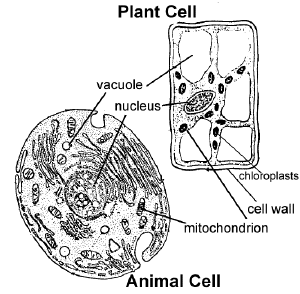BACKGROUND:
 Cells
are the fundamental units of living material. The bodies of all living things
are formed from cells, and without cells there would be no life. Every large
living thing is made of billions of cells. Cells
are the fundamental units of living material. The bodies of all living things
are formed from cells, and without cells there would be no life. Every large
living thing is made of billions of cells.
A cell contains special structures called organelles which have specific
functions for maintaining the health of the cell. These functions include
taking in food and breaking it apart into simple molecules, releasing energy
from food, building and repairing cell parts, getting rid of harmful wastes,
and making more cells.
There are thousands of
different kinds of living things that are made up of only single cells. They
are restrictive in what they can do, however, because one cell just can't
conquer the world.
In most plants and animals, the cells are
organized to do different types of jobs. In plants, for instance, there are
specialized root cells whose function is to take in minerals and water. These
specialized cells are arranged into tissues that do the same job. Muscle
tissue, for example, is made up of many individual muscle cells. Different
tissues that work together form organs. Examples of organs include the
stomach, kidneys, and lungs. Organs are groups of tissues that work together
to perform a specific function. Organs do not operate in isolation and
together they form systems, like the respiratory, circulatory, and digestive
systems.
PROCEDURE:
- Discuss the main organelles of a cell.
Emphasize the importance of the nucleus and its function. Explain the
differences between plant and animal cells, especially the presence of
chloroplasts and a rigid cell wall in plant cells.
- Have the students construct a paper
model of a plant cell and an animal cell by cutting and pasting from the
provided sheet. The major part is that the animal cell will not have a cell
wall and chloroplast.
|